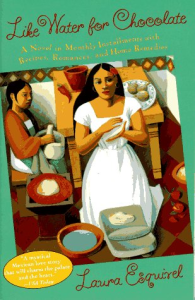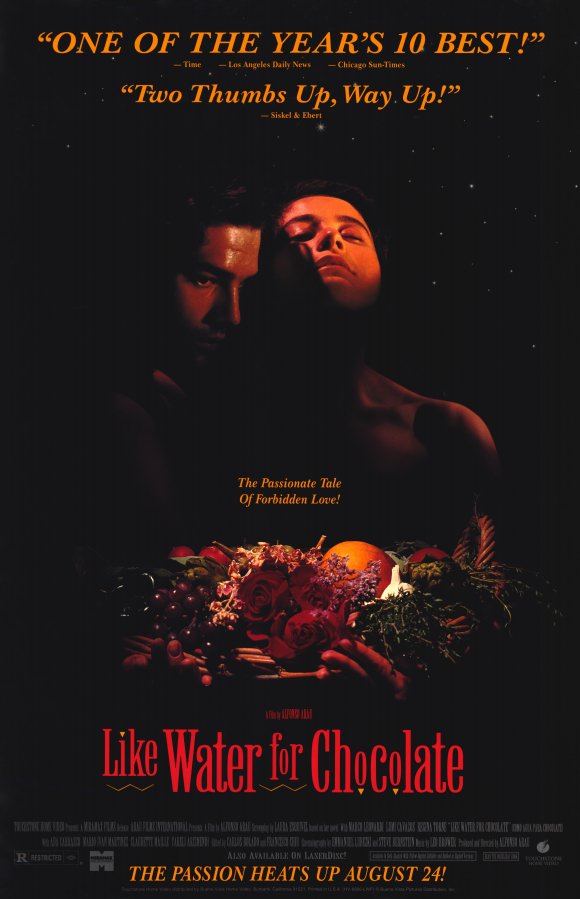 Whenever she closed her eyes she saw scenes from last Christmas, the first time Pedro and his family had been invited to dinner; the scenes grew more and more vivid, and the cold within her grew sharper. Despite the time that had passed since that evening, she remembered it perfectly: the sounds, the smells, the way her new dress had grazed the freshly waxed floor, the look Pedro gave her … That look! She had been walking to the table carrying a tray of egg-yolk candies when she first felt his hot gaze burning her skin. She turned her head, and her eyes met Pedro’s. It was then she understood how dough feels when it is plunged into boiling oil. The heat that invaded her body was so real she was afraid she would start to bubble — her face, her stomach, her heart, her breasts — like batter, and unable to endure his gaze she lowered her eyes and hastily crossed the room….
Whenever she closed her eyes she saw scenes from last Christmas, the first time Pedro and his family had been invited to dinner; the scenes grew more and more vivid, and the cold within her grew sharper. Despite the time that had passed since that evening, she remembered it perfectly: the sounds, the smells, the way her new dress had grazed the freshly waxed floor, the look Pedro gave her … That look! She had been walking to the table carrying a tray of egg-yolk candies when she first felt his hot gaze burning her skin. She turned her head, and her eyes met Pedro’s. It was then she understood how dough feels when it is plunged into boiling oil. The heat that invaded her body was so real she was afraid she would start to bubble — her face, her stomach, her heart, her breasts — like batter, and unable to endure his gaze she lowered her eyes and hastily crossed the room….
The Green Man video library has countless films in formats ranging from the newest (DVD) to formats so old that the very equipment used to watch them predates Babbage Machines by decades. All of which is carefully indexed by Liath ó Laighin, our Archivist, so it was easy to find this film. Having found it, I settled into our screening room to watch it again. I say ‘again’ because I watched it years before reading the novel. I just finished reading the novel, so I thought it was a good time to re-watch the film. Confused yet? What if I told you that there was virtually no difference ‘twixt book and film? Now are you confused?
Like Water for Chocolate is an erotic Mexican magic realism narrative about the power of a young woman’s over-powering lust, errr, love. Tita discovers that she has the power to greatly influence people with her recipes. When her tears fall into the sugar of the wedding cake she is baking for Pedro and Rosura, the guests who eat the cake begin to weep uncontrollably. The title, Like Water for Chocolate, refers to the temperature that water must be brought to in order to melt chocolate; it is also used as slang to describe sexual arousal, errrr, passion.
 Now, I was going to say simply that the film is a word-for-word telling of the book — only you see the tits in the film. Really nice tits. And much, much more. Wait a minute … wasn’t this a film review? Sort of. Possibly. So before returning to the film, let’s talk about the book. And a magical book it is. Even in the English translation! The Spanish I know is limited to what Robert Heinlein ever-so-politely called cantina Spanish, so I read it in English. The original Spanish version, Como agua para chocolat, was the top-selling book in Mexico in 1990. As a work of Latin magical realism, it can’t be topped by any other work to date. The narrator’s great-aunt is Tita, youngest of three daughters born to one of the vilest mothers ever, Mama Elena, the cruel matriarch of the family estate, the De la Garza ranch. Tita is rather special: even while still in Mama Elena’s womb, she wept so violently as her mother chopped onions that she caused an early labor which meant that Tita quite literally was born on the kitchen table where a fragrant noodle soup was being prepared. Tita was thus both blessed and cursed to be one with the food — more than a mere cook as her cooking is truly magical.
Now, I was going to say simply that the film is a word-for-word telling of the book — only you see the tits in the film. Really nice tits. And much, much more. Wait a minute … wasn’t this a film review? Sort of. Possibly. So before returning to the film, let’s talk about the book. And a magical book it is. Even in the English translation! The Spanish I know is limited to what Robert Heinlein ever-so-politely called cantina Spanish, so I read it in English. The original Spanish version, Como agua para chocolat, was the top-selling book in Mexico in 1990. As a work of Latin magical realism, it can’t be topped by any other work to date. The narrator’s great-aunt is Tita, youngest of three daughters born to one of the vilest mothers ever, Mama Elena, the cruel matriarch of the family estate, the De la Garza ranch. Tita is rather special: even while still in Mama Elena’s womb, she wept so violently as her mother chopped onions that she caused an early labor which meant that Tita quite literally was born on the kitchen table where a fragrant noodle soup was being prepared. Tita was thus both blessed and cursed to be one with the food — more than a mere cook as her cooking is truly magical.
Tita may be the best cook in all of Mexico, but in Mexico a century ago, tradition dictates that the youngest will never be allowed to marry as she must remain at home to care for her mother. But she has fallen madly in love, but Mama Elena says ‘no’ and instead arranges for Tita’s older sister to marry the one she would have. And the cruelty of this mother rivals that shown by wicked stepmothers in The Grimm Fairy Tales as she orders Tita to bake the wedding cake. You who read fairy tales will know that this is a very, very bad idea. The bitter tears that Tita weeps as she prepares the cake fall into the batter, transforming the cake in rather significant ways which are not always pleasant to those who consume it.
Like Water for Chocolate is about desire, love, lust, rebellion and, yes, death — which is only appropriate. We as viewers/readers are given a chance to see how the attitudes of the characters change over the course of time and how true love, once fully revealed, can never be held back even if the consequences of this true love are to be consumed by it. No, Tita does not find true, lasting love.
Not surprisingly, a recurring theme of both the book and film is food, which is used to represent all aspects of the vibrant, if troubled, Mexican culture. Hardly a scene goes by without someone eating or preparing a meal, and some of the more tasty chapters/scenes involve banquets. Both in the book and in the film, there’s a real feeling that food is more than just something one eats. Food here is a celebration of the helix of life and death, of consuming and being consumed. Though the landscape of Mexico may not appear to be life-bearing — a theme that also plays itself out in Terri Windling’s The Wood Wife, which is set almost entirely in Arizona where the landscape only appears to be arid — the food shows the abidance of the culture there.
Both the book and film must be experienced to be fully appreciated. It doesn’t matter which order you experience them in. The only meaningful difference between the two is that the book — as the subtitle of ‘A Novel in Monthly Installments, with Recipes, Romances, and Home Remedies’ would strongly suggest — has really amazing recipes and descriptions of food. The birth is described as ‘….Tita made her entrance into this world, prematurely, right there on the kitchen table amid the smells of simmering noodle soup, thyme, bay leaves and cilantro, steamed milk, garlic, and, of course, onion.’
One of the best films to come out of Latin America in many years, Like Water for Chocolate possesses an undeniably erotic quality that will make one rather, errr, hot. And that is as it should be. (I think that it’s terribly unfortunate, though, that the ending left an unpleasant taste in my mouth.)
The two primary actresses are excellent. I really wanted Tita to find happiness — especially with Pedro, but it was ordained not to be. As for Mama Elena, I hated her enough to want to see her strangled by Tita. Or poisoned by Tita, but that, given the dark fairy tale nature, was not to be. The actress who played her should get credit for creating such a nasty character! The actor who played Pedro was acceptable, but he didn’t have that much to do, but that is true of all the males in this film.
The DVD, as do most DVDs these days, has some extras. The third book of Jasper Fforde’s Thursday Next series has UltraBook(tm) — the replacement for the present book format. Fortunately the extras on this DVD are far more useful than the UltraBook(tm) format proved to be in that novel, as it includes English subtitles which really are needed unless you, unlike me, understand fluent Spanish.
The book (in English) is truly magical, the film is equally so. Laura Esquivel has written at least one awful book after this, but nothing to equal it. Savor it, consume it, and digest it slowly — you won’t regret the time spent!
(Doubleday, 1989)
(1993)
